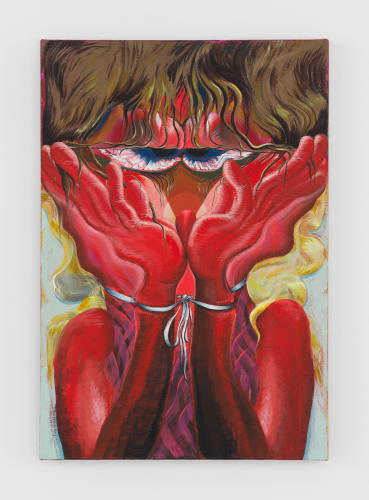
At first, the imagery in Bridget Mullen’s canvases for her show “Quitters” seemed difficult to parse; but I eventually found my way into her world by grooving to the works’ facture. Because she uses the ultra-matte vinyl paint Flashe, often in combination with acrylic or spray paint, the paintings’ surfaces look very dry, which somehow conflicts, in the eye’s mind, with the fluidity of her slyly workmanlike mark-making. The color is thinly applied in layers so that a sense of depth, volume, and plasticity coexists with an acute feeling for the flat surface—another perceptual conundrum. The effect is counterseductive in a curious way; it makes for a stance that is analytical but also intimately physical—a kind of deliberated immediacy. Impulse and control create an uneasy equilibrium.
Something similar might be said of the paintings’ imagery, consisting mainly of sliced and diced bits of cartoony figures, mostly limbs and heads, all “squeezing, bulging, marching, mirroring, hovering, shapeshifting, being and becoming hair,” as Aschely Cone writes in the exhibition text. Reinterpreted from their distant Looney Tunes or Mad magazine sources via Philip Guston and the Chicago Imagists, these unmoored body parts have been perversely recombined in arbitrary ways that owe a lot to Surrealism, though at times with an overlay of rhythmic repetition à la Italian Futurism. Not that Mullen is playing “spot that reference,” however; whatever she’s taken from her elective antecedents has been synthesized into a style custom-made for her rueful and ironic evocation of a subjectively perceived corporeal experience. Occasionally the results are nearly straightforwardly figurative, as in Free to Be You and Me, 2021—featuring a ruddy head that looks no less grotesque for being mostly hidden by a pair of hands daintily tied together with a blue ribbon and revealing a huge pair of heavy-lidded, bloodshot blue eyes—but usually things are less legible. Another portrait-like composition, Easels Browsers, 2022, likewise focuses on a head and hands, but this time the hands are manipulating—washing? arranging?—a blond coif. Under that hair and those squinting eyes, is that really a face, a head?—or is it a noseless, mouthless stump? And are those fleshy bulges just below the eyes displaced cheeks or cleavage? In any case, Mullen gives the image just enough readability to make its ultimate indecipherability more pointed. Uncertainty emerges as a truth worth hanging onto. As the artist once said in an interview, “Confusion and displacement are just as desirable as hyperawareness.” If you looked into a mirror and saw this alien creature meeting your gaze, you’d have to accept it was the real you . . . and maybe learn to like it.
Elsewhere, Mullen runs her recombinant psychobiological creations toward more abstract ends. Rather than the imagistic centrality teased by the elusive prospect of a face, allover patterning comes to the fore—see, for instance, the multiplying arms and red-gloved, stick-wielding hands in the lower portion of Future Farmers, 2022, though doing so may not make any clearer what you’re looking at in the painting’s top half; the general effect is of a system of organic pistons in operation. But, for all that, the piece was the closest thing to “pretty” in the show. Refracting through Quitters (2), 2019–22, is a pair of near-identical striding figures, all limbs and hair but faceless and without torsos, though clothed in red, or might they perhaps be a single figure seen at different points in time, once booted, once barefoot? The movement in which they/it are caught up—which is also somehow that of the space this multidimensional being attempts to traverse—is more like a fractured stasis. Cone sees the quitting of the work’s title as a gesture toward freedom, but the painting seems skeptical of escape as an option.

